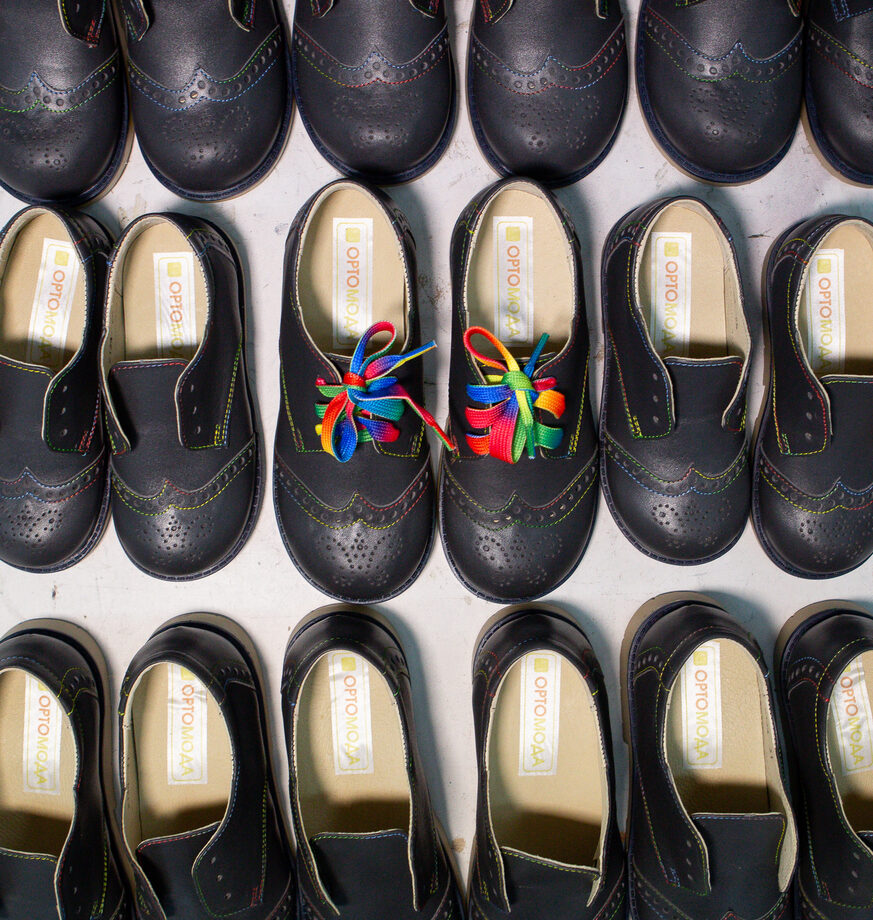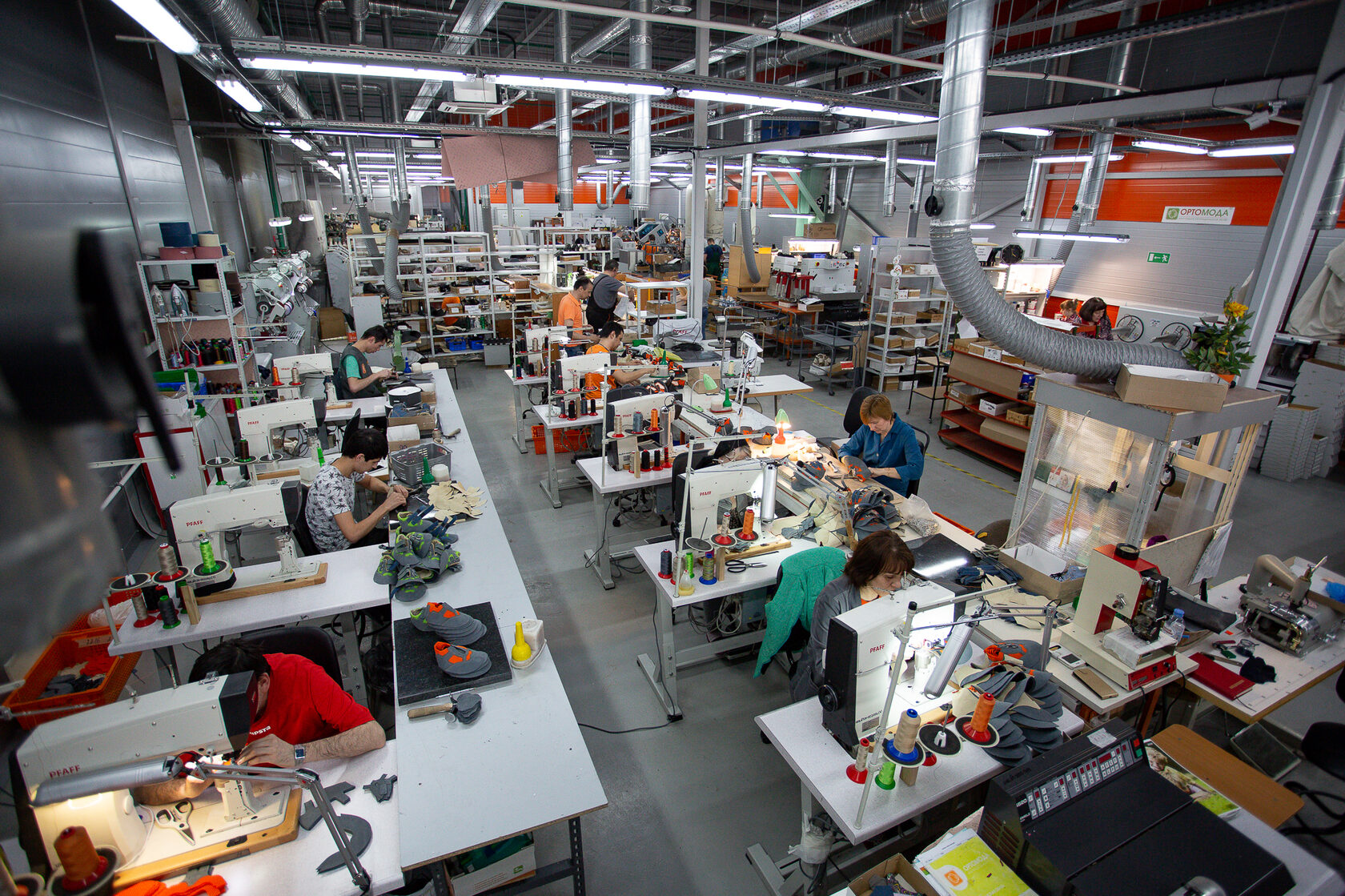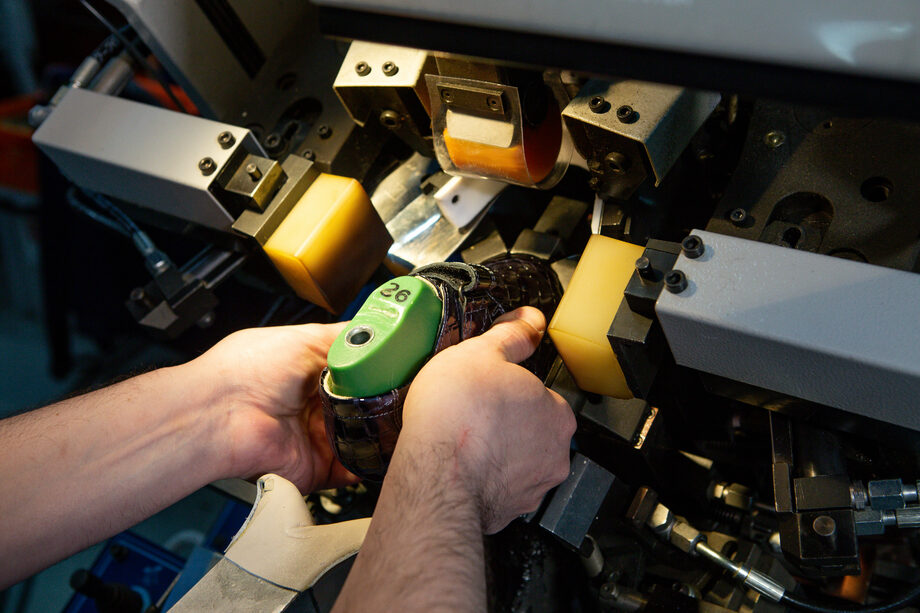
september 8, 2021
High Fashion Accessible to Everyone
Designer Galina Volkova on 'healthy' aesthetics
Galina Volkova is one of the pioneers of inclusive fashion in Russia. She is the founder of a company producing orthopaedic footwear and Russia's first tailor house for people with disabilities. Today, Galina Volkova develops goods for the most diverse audience and combines high fashion technologies with medical ones.
In September 2021, Orthomoda company celebrates its 20th birthday. Galina Volkova and her team have achieved great success over that time: thousands of people and dozens of specialized organisations working with people with disabilities from all over Russia send them their words of gratitude.
Galina Volkova is an amazing person whose energy, care, and professionalism in solving complicated tasks cause admiration in all those around. In the run-up to the company's birthday, Ms. Volkova told the Global Women Media news agency about how she had managed to combine science, creativity, charity, and business in her project. She also talked about the importance to be engaged in the development of inclusive fashion and footwear design in Russia and shared her plans and goals for the nearest future.
In September 2021, Orthomoda company celebrates its 20th birthday. Galina Volkova and her team have achieved great success over that time: thousands of people and dozens of specialized organisations working with people with disabilities from all over Russia send them their words of gratitude.
Galina Volkova is an amazing person whose energy, care, and professionalism in solving complicated tasks cause admiration in all those around. In the run-up to the company's birthday, Ms. Volkova told the Global Women Media news agency about how she had managed to combine science, creativity, charity, and business in her project. She also talked about the importance to be engaged in the development of inclusive fashion and footwear design in Russia and shared her plans and goals for the nearest future.

– How did the idea to create a company focusing on the production of inclusive footwear appear?
– I started my professional path in the fields of high fashion and new digital technologies. Feedback from a renowned artist who highly appreciated my footwear design shown at Moscow's fashion show was a big achievement for me. That was my first major success, after which my goods were presented in Berezka, which is a prestigious store in Moscow. I was very inspired by what had happened to me. In the Kabardino-Balkarian Republic, where I lived, many people were sceptical about my creative activities. After returning from Moscow, I was very much motivated and inspired. I created my own company producing design and dance shoes in my home region of Russia.
To develop further, I entered postgraduate studies at the Moscow State University of Design and Technology. I wanted to inspire and motivate my colleagues. At that time, I believe, much attention was paid to clothes designers. However, creators of fashionable footwear were almost ignored.
Assisted by the Rector of the Moscow State University of Design and Technology, I launched Russia's first contest for footwear designers.
My husband is a military doctor with many years of professional experience. He set a task for me to create footwear focused on people with disabilities. I accepted that challenge. That is when I had an idea to combine high fashion and orthopaedics.
Since that time, I have worked hard not only on my project but also on myself. I immersed in the topic and expanded my understanding of what people with disabilities really needed. At that time, Russia was only beginning to develop an accessible and inclusive environment. I can say that I was a pioneer in the field of inclusive fashion. Today, there is an increasing number of such initiatives. I find that trend positive and useful for society.
In 2002, we hosted the first fashion shows of inclusive clothes and footwear in Düsseldorf. That was fascinating! I saw happiness in the eyes of our models, heard many words of gratitude, and watched the audience's admiration. All that inspires me very much to this day.
It is important to understand that inclusive fashion is not only about 'dressing' people with different disabilities. The main task is to create clothes and footwear that would be aesthetic and as comfortable as possible for people with particular features of the body.
– I started my professional path in the fields of high fashion and new digital technologies. Feedback from a renowned artist who highly appreciated my footwear design shown at Moscow's fashion show was a big achievement for me. That was my first major success, after which my goods were presented in Berezka, which is a prestigious store in Moscow. I was very inspired by what had happened to me. In the Kabardino-Balkarian Republic, where I lived, many people were sceptical about my creative activities. After returning from Moscow, I was very much motivated and inspired. I created my own company producing design and dance shoes in my home region of Russia.
To develop further, I entered postgraduate studies at the Moscow State University of Design and Technology. I wanted to inspire and motivate my colleagues. At that time, I believe, much attention was paid to clothes designers. However, creators of fashionable footwear were almost ignored.
Assisted by the Rector of the Moscow State University of Design and Technology, I launched Russia's first contest for footwear designers.
My husband is a military doctor with many years of professional experience. He set a task for me to create footwear focused on people with disabilities. I accepted that challenge. That is when I had an idea to combine high fashion and orthopaedics.
Since that time, I have worked hard not only on my project but also on myself. I immersed in the topic and expanded my understanding of what people with disabilities really needed. At that time, Russia was only beginning to develop an accessible and inclusive environment. I can say that I was a pioneer in the field of inclusive fashion. Today, there is an increasing number of such initiatives. I find that trend positive and useful for society.
In 2002, we hosted the first fashion shows of inclusive clothes and footwear in Düsseldorf. That was fascinating! I saw happiness in the eyes of our models, heard many words of gratitude, and watched the audience's admiration. All that inspires me very much to this day.
It is important to understand that inclusive fashion is not only about 'dressing' people with different disabilities. The main task is to create clothes and footwear that would be aesthetic and as comfortable as possible for people with particular features of the body.
– Do you continue to create orthopaedic footwear? Do your collections include other models?
– When I started working in this field, I strived to bring new materials and technologies used in the high fashion and footwear industries into orthopaedics. To make that possible, I carried out serious research. I studied the foot structure and existing problems in this field. I immersed myself in a whole new area of activity to apply my professional skills and knowledge there.
I used that method of working for 10 years and created a diversified range of orthopaedic footwear. However, at some moment, I decided to try to arrange my work in the reversed direction. By that moment, I had enough experience and knowledge in orthopaedics and could use them when creating usual designer shoes. The idea turned out very relevant because the trend of a healthy lifestyle was becoming increasingly popular.
The prevention of musculoskeletal disorders plays a big role in every person's life. Our feet are under considerable strain daily. We can decrease it with the right and stylish shoes.
At first, I began to share my orthopaedic competencies with different brands producing fashionable footwear. Later I launched my own production. I created orthopaedic designs for different social groups. I had a footwear collection for women drivers, office workers, and teachers. I created elegant business shoes, which are comfortable to wear all day long.
I have loved dancing since my childhood. That interest inspired me to create dance shoes with orthopaedic elements. They are comfortable for dancers and help them train the right muscles at the same time.
Today, our company creates not only complex orthopaedic shoes but also products for usual customers. Those are 'super-comfort' class shoes. We also take into account peculiarities of instep, flat-footedness, Hallux Valgus, and diabetic foot.
– Does that mean that Orthomoda is a whole science requiring not only design-related, creative, and entrepreneurial skills but also deep research?
– Yes, research is a key element of my work. I have a PhD in Economics. Research and exploration of new topics have always been fascinating and important processes for me.
All my three areas of development (orthopaedics, business, and design) are very important for me today. The synthesis of these fields helped me create the Orthomoda company, a unique project that has been developing successfully for many years.
I draw ideas and inspiration from science. I carry them out through creativity in design. Business is what allows my project to stay afloat and get resources for development.
When one activity combines sincere involvement, professionalism, monetization, it gives an incredible boost of energy. Another fact that serves as a powerful impulse for my activities is that I do social entrepreneurship. This field doesn't bring much income but it gives something much more valuable: the gratitude of people and their sincere emotions.
There are people who can't walk without proper footwear, for example, children with cerebral palsy. It is difficult to convey in words the feelings that I experience when they thank us for what we do for them. That can't leave me indifferent and gives me motivation.
– When I started working in this field, I strived to bring new materials and technologies used in the high fashion and footwear industries into orthopaedics. To make that possible, I carried out serious research. I studied the foot structure and existing problems in this field. I immersed myself in a whole new area of activity to apply my professional skills and knowledge there.
I used that method of working for 10 years and created a diversified range of orthopaedic footwear. However, at some moment, I decided to try to arrange my work in the reversed direction. By that moment, I had enough experience and knowledge in orthopaedics and could use them when creating usual designer shoes. The idea turned out very relevant because the trend of a healthy lifestyle was becoming increasingly popular.
The prevention of musculoskeletal disorders plays a big role in every person's life. Our feet are under considerable strain daily. We can decrease it with the right and stylish shoes.
At first, I began to share my orthopaedic competencies with different brands producing fashionable footwear. Later I launched my own production. I created orthopaedic designs for different social groups. I had a footwear collection for women drivers, office workers, and teachers. I created elegant business shoes, which are comfortable to wear all day long.
I have loved dancing since my childhood. That interest inspired me to create dance shoes with orthopaedic elements. They are comfortable for dancers and help them train the right muscles at the same time.
Today, our company creates not only complex orthopaedic shoes but also products for usual customers. Those are 'super-comfort' class shoes. We also take into account peculiarities of instep, flat-footedness, Hallux Valgus, and diabetic foot.
– Does that mean that Orthomoda is a whole science requiring not only design-related, creative, and entrepreneurial skills but also deep research?
– Yes, research is a key element of my work. I have a PhD in Economics. Research and exploration of new topics have always been fascinating and important processes for me.
All my three areas of development (orthopaedics, business, and design) are very important for me today. The synthesis of these fields helped me create the Orthomoda company, a unique project that has been developing successfully for many years.
I draw ideas and inspiration from science. I carry them out through creativity in design. Business is what allows my project to stay afloat and get resources for development.
When one activity combines sincere involvement, professionalism, monetization, it gives an incredible boost of energy. Another fact that serves as a powerful impulse for my activities is that I do social entrepreneurship. This field doesn't bring much income but it gives something much more valuable: the gratitude of people and their sincere emotions.
There are people who can't walk without proper footwear, for example, children with cerebral palsy. It is difficult to convey in words the feelings that I experience when they thank us for what we do for them. That can't leave me indifferent and gives me motivation.

– How is the production arranged? How much did the company develop over 20 years of its existence?
– Today, we produce inclusive and usual footwear taking into account orthopaedic peculiarities. We also carry out small but unique production of clothes for people with disabilities. Our company has become the first enterprise in Russia creating clothes for extremely sick persons and bedridden patients. We develop items of clothing that are adjusted to different people's biological constitutions and are easy to use when dressing up.
Over the time of Orthomoda's existence, we have not only expanded the company and the range of its products but also digitalized our work.
Today, we can contact our clients online and scan their feet using special programmes to consider all the peculiarities when creating individual footwear. That technology has become our major achievement, which is ahead of its time. During the pandemic, when all businesses experienced lockdown-caused challenges, we already had well-checked and effective tools for remote working with clients.
The team that we have formed over the years of the company's development is another significant achievement. Today, Orthomoda employs about 160 people of different ages. There are also people with disabilities among them. I find this synthesis really important and useful in many aspects. Elderly people who continue to work have the opportunity to be socialized and share their experience and knowledge with the young generation. Young people invest much energy and a lot of creative ideas into our work process. People with disabilities are especially valuable employees. They can not only perform their professional duties but also share their opinion on making our products better. They suggest their ideas on what else we can do for people with disabilities. Such an interaction makes our big team even more effective.
Today, we provide stores and social institutions countrywide with our products. Production and selling processes are partially sponsored by the federal budget. That makes it possible to make inclusive fashion more accessible.
The company maintains balance thanks to participation in tenders, monetary support of the project from the federal budget and charity funds, and our for-profit activities.
Importantly, many of our inclusion-related projects don't bring income and require serious investments. For example, the production of clothes for seriously ill persons results in 2.5 million rubles of losses. However, we keep on creating such goods and providing the needy with them for free or at a low cost. That is possible thanks to our income from selling usual footwear, support from the government, and donations of concerned people.
– Today, we produce inclusive and usual footwear taking into account orthopaedic peculiarities. We also carry out small but unique production of clothes for people with disabilities. Our company has become the first enterprise in Russia creating clothes for extremely sick persons and bedridden patients. We develop items of clothing that are adjusted to different people's biological constitutions and are easy to use when dressing up.
Over the time of Orthomoda's existence, we have not only expanded the company and the range of its products but also digitalized our work.
Today, we can contact our clients online and scan their feet using special programmes to consider all the peculiarities when creating individual footwear. That technology has become our major achievement, which is ahead of its time. During the pandemic, when all businesses experienced lockdown-caused challenges, we already had well-checked and effective tools for remote working with clients.
The team that we have formed over the years of the company's development is another significant achievement. Today, Orthomoda employs about 160 people of different ages. There are also people with disabilities among them. I find this synthesis really important and useful in many aspects. Elderly people who continue to work have the opportunity to be socialized and share their experience and knowledge with the young generation. Young people invest much energy and a lot of creative ideas into our work process. People with disabilities are especially valuable employees. They can not only perform their professional duties but also share their opinion on making our products better. They suggest their ideas on what else we can do for people with disabilities. Such an interaction makes our big team even more effective.
Today, we provide stores and social institutions countrywide with our products. Production and selling processes are partially sponsored by the federal budget. That makes it possible to make inclusive fashion more accessible.
The company maintains balance thanks to participation in tenders, monetary support of the project from the federal budget and charity funds, and our for-profit activities.
Importantly, many of our inclusion-related projects don't bring income and require serious investments. For example, the production of clothes for seriously ill persons results in 2.5 million rubles of losses. However, we keep on creating such goods and providing the needy with them for free or at a low cost. That is possible thanks to our income from selling usual footwear, support from the government, and donations of concerned people.

– What plans for the future development of the company do you have?
– Orthomoda company is already 20 years old. It is modern digital production, which is ready for new challenges. We can receive remote digital orders and process them in special programmes. 20 years is the age when a child is grown up and a parent can let him or her go calmly. I feel that I have done everything I could for this enterprise. That's why now I have the opportunity to pay more attention to new projects.
I thought a lot about the problems related to the sunset of small-sized businesses focusing on the creation of designer footwear in Russia. Today, major companies keep on being prosperous but some talented masters often stop their work because of not finding the financial response to their activity.
I decided to bring together and buy small-sized businesses and unite them under my brand to contribute to improving the situation. At the same time, I preserved their identity.
Nowadays we have different vectors for development in that area. By bringing together the enterprises, I create a laboratory that will work out individual footwear. It also deals with orders for famous design collections. Of course, I continue my own development by creating design footwear with orthopaedic elements.
– Orthomoda company is already 20 years old. It is modern digital production, which is ready for new challenges. We can receive remote digital orders and process them in special programmes. 20 years is the age when a child is grown up and a parent can let him or her go calmly. I feel that I have done everything I could for this enterprise. That's why now I have the opportunity to pay more attention to new projects.
I thought a lot about the problems related to the sunset of small-sized businesses focusing on the creation of designer footwear in Russia. Today, major companies keep on being prosperous but some talented masters often stop their work because of not finding the financial response to their activity.
I decided to bring together and buy small-sized businesses and unite them under my brand to contribute to improving the situation. At the same time, I preserved their identity.
Nowadays we have different vectors for development in that area. By bringing together the enterprises, I create a laboratory that will work out individual footwear. It also deals with orders for famous design collections. Of course, I continue my own development by creating design footwear with orthopaedic elements.
– Any businesses, especially social ones, require a huge amount of effort. What is the source of your energy?
– Social entrepreneurship is a continuous exchange of emotions and inspiration. I create footwear and clothes to support people with disabilities and get huge feedback from them in return.
I admire people who turn to us with a proposal to provide us with social or charitable assistance. Some people contribute to our cause financially and others are ready to join it personally. Society's belonging, its care, and the feeling of doing one common cause jointly give us an incredible impetus to move forward.
– What would you wish women of the world?
– I am a member of the BRIСS Women Business Alliance. We regularly host meetings where we not only discuss the solution of particular tasks and problems but also exchange our inspiration and support with one another. Our communication results in many ideas that I would like to share with women from different countries.
My main wish is to always remember that the source of energy and strength is within ourselves. Supporting that powerful internal resource is only possible by means of communication with one another.
When we are open to the exchange of knowledge, experience, and emotions, we not only give something to the world but also get the same in return. That gives us the energy to create: shape favourable atmosphere in the family, among colleagues, and in society. Then we reach the Love making it easier and more interesting for us to move forward and do art, business, science, and carry out other activities.
Viktoria Gusakova, Global Women Media news agency
Translated by Nikolay Gavrilov
You can also read this article on Global Women Media.
– Social entrepreneurship is a continuous exchange of emotions and inspiration. I create footwear and clothes to support people with disabilities and get huge feedback from them in return.
I admire people who turn to us with a proposal to provide us with social or charitable assistance. Some people contribute to our cause financially and others are ready to join it personally. Society's belonging, its care, and the feeling of doing one common cause jointly give us an incredible impetus to move forward.
– What would you wish women of the world?
– I am a member of the BRIСS Women Business Alliance. We regularly host meetings where we not only discuss the solution of particular tasks and problems but also exchange our inspiration and support with one another. Our communication results in many ideas that I would like to share with women from different countries.
My main wish is to always remember that the source of energy and strength is within ourselves. Supporting that powerful internal resource is only possible by means of communication with one another.
When we are open to the exchange of knowledge, experience, and emotions, we not only give something to the world but also get the same in return. That gives us the energy to create: shape favourable atmosphere in the family, among colleagues, and in society. Then we reach the Love making it easier and more interesting for us to move forward and do art, business, science, and carry out other activities.
Viktoria Gusakova, Global Women Media news agency
Translated by Nikolay Gavrilov
You can also read this article on Global Women Media.
Previous news
© All Rights Reserved.

